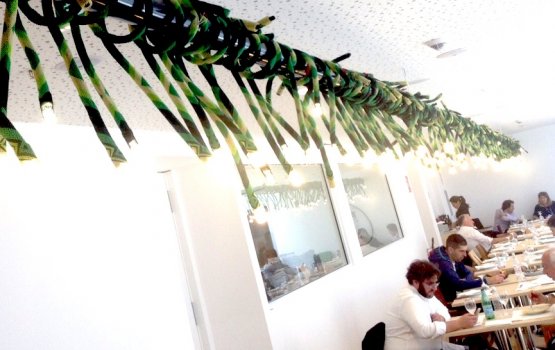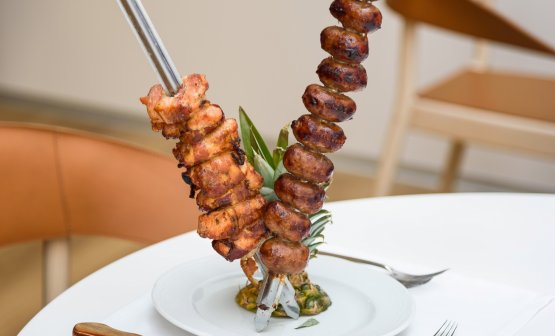The gigantic stand of Brazil (over 4,000 sq. m.) is built around the concept of net. On instinct, you’d think about the one with which Neymar knocked out FC Bayern Munich last night, yet for once football is out of the picture. So are samba, fio dental or caipirinha, because if there’s a lesson Expo is giving us, is that in 2015 it is time to let darkness fall over any stereotype, blurring paradigms that no longer mirror the current spirit.
In the green-and-gold pavilion, the net is first of all a real one: it exists. Hundreds of kids know it well, as each day they queue to climb and then jump on the elastic net which, so far, together with the tree of life and the madunina, is one of the most portrayed objects at the World Fair. Every small step on it is translated into impulses that change the surrounding sound and light in a slightly perceptible way.
The fun excursus is the coat wrapping a rather severe pavilion, divided into three floors climbing three concepts: technology, culture, sharing. The net, in this case the metaphoric one, is the one they would like to weave, between their country, a world leader in food production, and international firms, which in many cases have a more developed savoir-faire. A business-to-business approach over which we pass for now.

The churrascaria on the top floor is lit with lights designed by indigenous Yawanawà people
So, after a quick look at vegetables, plants, flowers and fruits underneath the real net, we stay at the ground floor to visit the most interesting part. It’s an exhibition called
Alimentário|arte e construção do patrimônio alimentar brasileiro (art and building of Brazil’s food heritage) and seeks to define the opportunities for dialogue between art and gastronomy, two disciplines – as we’ve said at length – that after years (millennia) of incompatibility, are finally sniffing each other with canine dedication.
It includes installations, texts, historical documents, kitchen tools, photos and videos expressing the greatness of a cuisine that over the centuries was harmonised by African, indigenous and Portuguese influences. These arrive straight to your nose, for instance in Ernesto Neto’s perfumed installation: cloves, turmeric, black pepper and cumin powerfully emanating from a bizarre sculpture. Please note that the exhibition – much richer than the space we can grant here – ends at the end of May, hurry up.

And on the dish? Churrasco, grilled meat very popular, especially in the south of the country (FT Foto)
How about food? It is confined to two spaces: on the ground floor there’s
Bar do Brazil, an informal space where to gulp down a
Pão de queijo (cheese sandwich) or a
Linguiça (sausage) garnished in various ways, while sipping
suco fresco or
cerveja. On the first floor there’s a slightly more elegant
churrascaria seating 40 people. Each chair is different and the menu includes a tasting menu (45 euros) comprising 3 dishes:
Salpicão de frango e maionese (Chicken salad with yogurt sauce and potatoes);
Guarnições (rice, vinaigrette, feijoada and fried bananas) and an imperial
Rodizio de carne (barbecued chicken, sausage, pork, turkey and bacon, pineapple and cinnamon).
Too bad the programme does not comprise any space for the new generation of super chefs, the ones who are slowly revolutionising the country’s culinary grammar. A small incoherence for a country that is projected into the future as few others.